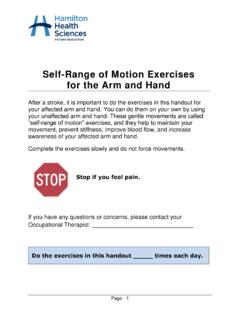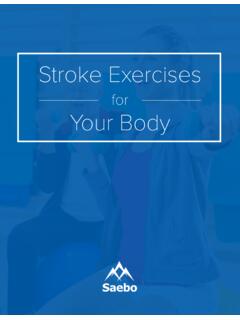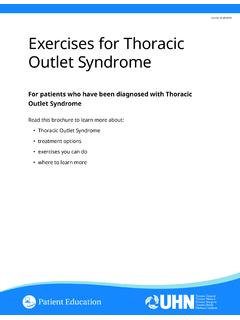Transcription of 20 ESSENTIAL DESK EXERCISES YOU CAN DO WITHOUT …
1 National Aeronautics and Space AdministrationDeskFit20 ESSENTIAL desk EXERCISES YOU CAN DO WITHOUT LEAVING YOUR OFFICE OR HOME WORKSPACEC reated by the NASA Headquarters Fitness CenterTanya Johnson, Marceleus Venable, and Kimber HEADQUARTERSI CHOOSE TO BEHEALTHYSAFETY AND OCCUPATIONALHEALTH The Department of Health and Human Services Physical Activity Guidelines for Americans (second edition) recommends that all adults need at least 150 to 300 minutes of moderate-intensity aerobic (cardiovascular) activity and at least two days of muscle-strengthening activity each week. The foremost guideline for all adults is to sit less and move more.
2 There is a strong correlation between sedentary behavior and increased risk of all causes of mortality, including heart disease, cancer, and numerous metabolic diseases. Regular physical activity helps to manage chronic health condi-tions, such as hypertension, diabetes, depression, arthritis, dementia, and obesity. It provides long-term benefits for reducing anxiety, improving sleep and cognition, lower-ing risk of injuries, and maintaining a healthy to the Centers for Disease Control and Prevention, one in four adults sits more than 8 hours a day, and half of Americans do not meet weekly physical activity guidelines.
3 Many jobs are considered sedentary, and employees frequently work from home, so it can be challenging to sit less and move shows that working professionals who exercise during the day feel healthier and experience positive associations with job performance, including improvement in time management skills and mental performance. Employees are more likely to demonstrate better moods, increased motivation, greater stamina to complete work, less stress, and better interactions with coworkers. Ten Tips To Stay Healthy at Work or While Working from Home:1 Ensure that your workspaces in the office and at home are ergonomically set up to prevent Take a break from sitting every 30 minutes.
4 A brief 5 10-minute break can help rejuvenate your mind and prevent chronic pain. 3 Walk and use the stairs whenever Alternate sitting and standing throughout the Offer walking meetings as alternatives to sitting in conference Schedule time to exercise daily as a priority as you would plan other important work responsibilities. 7 Break up physical activity into smaller durations of time such as 10 minutes before work, 10 minutes at lunch, and 10 minutes after work if longer durations of exercise do not fit within your Incorporate microbreaks of 1 2 minutes every 30 60 minutes to stand up and stretch your entire Use a hands-free headset for your phone so you can move around Eat nutritious meals and keep healthy snacks further information or assistance with staying healthy.
5 Please contact the NASA Headquarters Fitness Ways Excessive and Improper Sitting Can Harm YouHeadSitting for long periods of time can cause blood clots, which can travel to the brain causing a are twice as likely to develop a pulmonary embolism or blood clot if you sit most of the reduction of physical activity leads to hyper-tension or high blood sitting contributes to obesity and colon cancer. Enzymes in the blood vessels of muscles responsible for burning fat shut down, leading to the disruption of the body s method of metabolizing in the feet can be caused by poor circulation. It can also cause nerve damage or pressure on nerves when you sit for long retained in the legs during the day moves to the neck and contributes to sleep apnea.
6 Neck muscles are stressed, leading to who live a sed-entary lifestyle are up to twice as likely to develop diabetes and heart disease than those who move for long periods of time places a high amount of pres-sure on the spine. Over time, sitting can result in compression of the spinal disks. Because muscles are tight from pressure, sudden movements can lead to collects in the legs while we are sitting. Standing up and walking helps pump it through our Excessive and Improper Sitting All Day Affects the BodyNeck gets tense and tightTrapezius muscle gets strainedDiscs in lower back begin to bulgeHips get weakKnee pain developsSciatica developsFeet become flatterSTAND UP for your HEALTH and BREAK UP your extended sitting ESSENTIAL desk EXERCISES YOU CAN DO WITHOUT LEAVING YOUR OFFICE OR HOME WORKSPACEDESKFITEXERCISESP rogram Recommendations*Stretches and EXERCISES may be completed any time during the day.
7 They do not need to be completed all at once. If it is more convenient for you to spread the stretches or EXERCISES throughout the day, that is effective for improving health.*For a suggested program, aim to complete the EXERCISES on Monday, Wednesday, and Friday and the stretches on Tuesday and Thursday one week. Then, alternate to stretches on Monday, Wednesday, and Friday and EXERCISES on Tuesday and Thursday the following week and repeat the cycle.*Take a break from prolonged sitting every 30 minutes.*A 5-10 minute break will recharge your mind and prevent chronic pain. Focus on short micro breaks of 1-2 minutes every 30-60 minutes to stand up and stretch your body.
8 *Alternate sitting and standing throughout the further assistance with EXERCISES and stretches, please contact the NASA Headquarters Fitness MARCHESSit on the chair with your back straight. Bend your legs at the knees and run on the spot with short, quick steps as fast as you can for 15 20 LEG EXTENSIONSSit on the edge of your chair with your arms by your sides. Extend your right leg out straight and flex your foot so that just the right heel is on the floor (keeping your foot flexed engages the muscles in the shin and ankle). Lift your leg up as high as you can WITHOUT rounding your back. Hold for two counts, then lower.
9 Repeat with the other leg. Perform 10 reps on each REVERSE SHOULDER FLYSit on the edge of the chair and lean forward while keeping your lower back naturally arched. Your palms should be facing each other. Raise your arms straight out from your sides. Pause and then slowly return to the starting position. Repeat the exercise 15 sitting increases risk of spinal, shoulder, carpel tunnel, and leg disordersSTANDING CALF RAISESS tand up behind your chair and hold on for support. Raise your heels off the floor until you are standing on your toes. Slowly lower yourself back to the 12 15 times. EXERCISESSEATED TORSO TWISTSSit on the edge of the chair, bend your legs at the knees, and lean slightly back WITHOUT round-ing your spine.
10 Bend your arms so your elbows are level with the bottom of your ribcage. Pull your navel in and twist slowly to the left. Inhale and twist to the right. Repeat the exercise dynamically 20 times SIT AND STANDS tand in front of the chair with your legs shoul-der-width apart. Squat down like you are sitting on the chair but WITHOUT actually touching it. Maintain a proper position: back straight, knees above the feet, weight on the heels. Straighten your legs to go back to the starting position. Repeat the movement 10 15 PUSH-UPSW hile standing, position yourself a few feet from your desk . Keep your feet together.


















